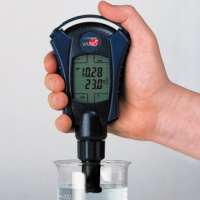








In chemistry, pH is the negative log of the activity of the hydrogen ion in an aqueous solution. Solutions with a pH less than 7 are said to be acidic and solutions with a pH greater than 7 are basic or alkaline. Pure water has a pH of 7.
The modern, electronic pH meter was invented about a quarter century later, around 1934/5, when American chemist Arnold Beckman (1900–2004) figured out how to hook up a glass electrode to an amplifier and voltmeter to make a much more sensitive instrument.
pH meter, electric device used to measure hydrogen-ion activity (acidity or alkalinity) in solution. Fundamentally, a pH meter consists of a voltmeter attached to a pH-responsive electrode and a reference (unvarying) electrode.
The pH of a solution is a measure of the molar concentration of hydrogen ions in the solution and as such is a measure of the acidity or basicity of the solution.
Tare weight is accounted for in kitchen, analytical (scientific) weighing scales and other scales which include a button that resets the zero of the scale display when an empty container is placed on the weighing platform, in order to subsequently display only the weight of the contents of the container.
Working Principle
A typical pH meter has two basic components: the meter itself, which can be a moving-coil meter (one with a pointer that moves against a scale) or a digital meter (one with a numeric display), and either one or two probes that you insert into the solution you're testing. To make electricity flow through something, you have to create a complete electrical circuit; so, to make electricity flow through the test solution, you have to put two electrodes (electrical terminals) into it. If your pH meter has two probes (like the one in the photo at the top of this article), each one is a separate electrode; if you have only one probe, both of the two electrodes are built inside it for simplicity and convenience.
The electrodes aren't like normal electrodes (simple pieces of metal wire); each one is a mini chemical set in its own right. The electrode that does the most important job, which is called the glass electrode, has a silver-based electrical wire suspended in a solution of potassium chloride, contained inside a thin bulb (or membrane) made from a special glass containing metal salts (typically compounds of sodium and calcium). The other electrode is called the reference electrode and has a potassium chloride wire suspended in a solution of potassium chloride.